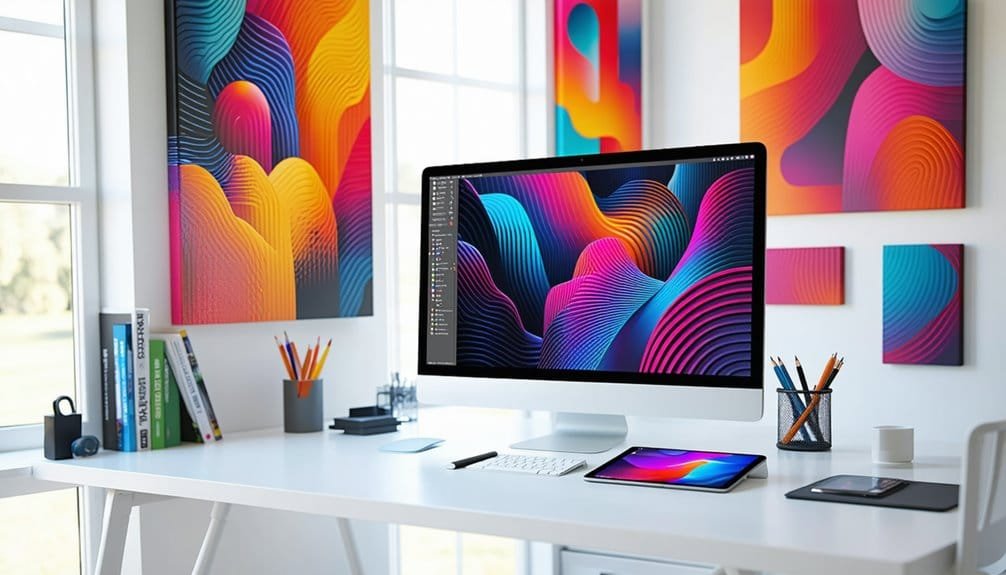Choosing top platforms for NFT art is important for enhancing your experience in the booming digital art market. These platforms offer diverse features tailored for creators and collectors. For instance, OpenSea is user-friendly with high traffic, while Rarible allows customization and artist royalties. Fees vary, with OpenSea charging 2.5% on transactions, making it necessary to compare structures that align with your needs. Security is another critical factor; established platforms implement strong measures to protect your assets. By selecting the right platform, you can guarantee a smooth engagement in this evolving space, offering you the best opportunities in NFT art. Further insights await you.
Table of Contents
Brief Overview
- Diverse Offerings: Each platform caters to different types of digital art, allowing creators and collectors to find the right fit for their needs.
- User Engagement: Innovative features like exclusive drops and customizable storefronts enhance user interaction and foster community among artists and collectors.
- Strong Security: Leading platforms implement robust security measures, such as encryption and smart contract audits, to protect users’ digital assets.
- Flexible Fee Structures: Competitive fee structures across platforms ensure artists can maximize earnings while providing collectors with fair pricing options.
- Growing Market: The NFT market is rapidly expanding, with projections of significant growth, offering opportunities for creators and collectors alike.
Overview of NFT Art Platforms
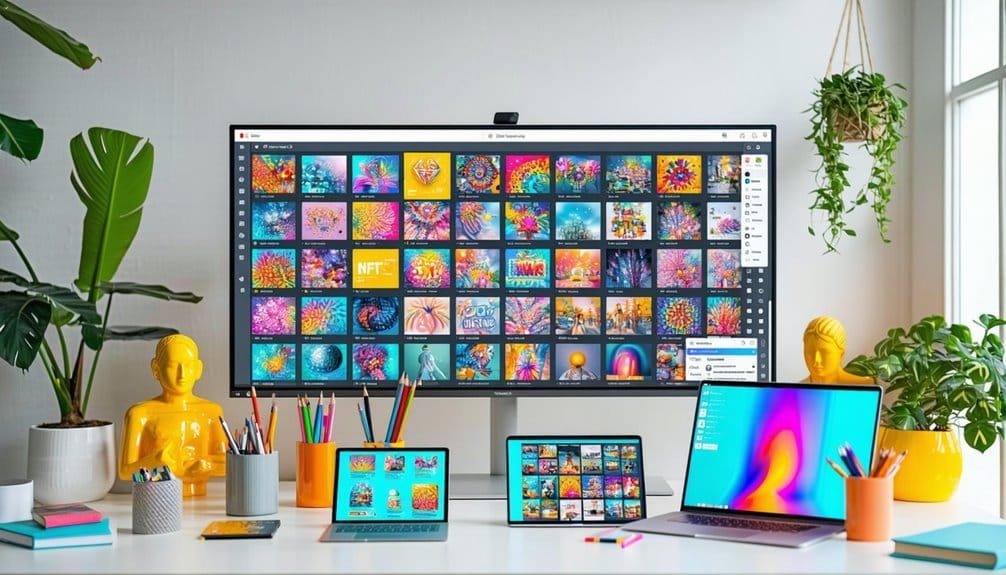
As you explore the world of platforms for NFT art, you’ll discover a diverse range of options tailored for creators and collectors alike. Each platform has unique features that cater to different needs, making NFT platform comparisons essential for making informed decisions. For instance, OpenSea stands out due to its support for multiple blockchains, including Ethereum, Polygon, Solana, and Arbitrum. This accessibility appeals to a wider audience of creators and collectors.
On the other hand, platforms like Foundation focus on high-quality digital art and provide exclusive artist experiences, operating solely on the Ethereum blockchain. If you’re looking for high-end NFT art, Nifty Gateway collaborates with renowned artists and brands, making it a popular choice for unique drops. Conversely, SuperRare emphasizes exclusivity and curated artistic expression, which may limit access but guarantees a premium experience. Additionally, the art NFT market size grew to $41 billion in a year, indicating a robust demand for these platforms.
Rarible takes a decentralized approach, allowing community influence through its RARI token, making it suitable for creators wanting more control over their work. For beginners, Mintable is an ideal choice, as it supports fiat currencies and offers a user-friendly interface. Additionally, many marketplaces, such as Blur, are introducing zero platform fees, which can significantly benefit both creators and collectors.
Understanding these options will help you navigate the NFT landscape more safely. Each platform’s fee structure varies as well, from OpenSea’s 2.5% on secondary sales to SuperRare’s 15%. By weighing these factors, you can better assess the artist experiences each platform offers, guaranteeing you choose one that aligns with your goals in the NFT art space.
Key Features of Each Platform
Exploring the diverse landscape of NFT art marketplace websites reveals a variety of key features that cater to different preferences and needs. When you immerse yourself in platform comparisons, it becomes clear that each option has unique offerings. For instance, OpenSea is recognized for its general NFT market, supporting both fixed prices and auctions, while Foundation focuses on high-quality digital art, utilizing a reserve price and 24-hour auction system. Rarible stands out with user-set royalties, allowing artists to earn up to 50% on secondary sales.
KnownOrigin, SuperRare, and Nifty Gateway emphasize curated experiences. KnownOrigin offers fixed prices and timed auctions, while SuperRare employs 24-hour auctions after the first bid. Nifty Gateway combines buy-it-now options with timed auctions, providing flexibility for buyers and sellers. The global NFT market is projected to grow significantly, indicating a rising interest in these platforms. Furthermore, as the concept of non-fungible tokens becomes more mainstream, the demand for diverse NFT art platforms is likely to increase.
Mintable, Binance NFT, and Crypto.com cater to a broader audience. Mintable operates without auctions, allowing for straightforward buy-it-now sales. Binance NFT supports various NFTs, including art and collectibles, while Crypto.com boasts no transaction fees, appealing to a wide user base.
Security is paramount across these platforms. Most offer robust help centers and technical support, ensuring you can navigate any issues. Additionally, many allow for payment through various methods, including credit cards and cryptocurrencies, enhancing accessibility. By considering these key features and user experiences, you can make an informed decision about which platform best suits your needs in the evolving world of NFT art.
Fees and Commission Structures
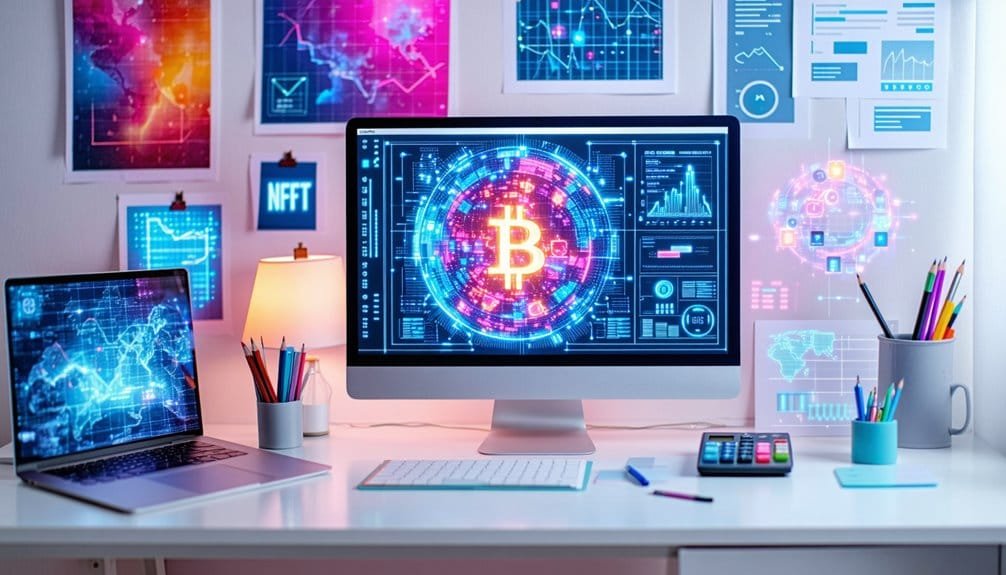
Maneuvering the key features pricing of platforms for NFT art is essential for both creators and collectors. Understanding these financial aspects can help you make informed decisions that align with your goals. Here’s a brief fee comparison across popular platforms:
- OpenSea: 2.5% on secondary sales; 2.5% to 10% on primary mints.
- Rarible: 2.5% fee for both buyers and sellers on transactions.
- Binance NFT: Only 1% fee for transactions.
- Nifty Gateway: 5% fee for V1 listings, 2.5% for V2.
- LooksRare: 2% sales fee, shared with $LOOKS stakers.
When you investigate the commission breakdown, the differences become even clearer. For primary sales, platforms like SuperRare and KnownOrigin charge a hefty 15% commission, while Foundation offers a more modest 5% through auctions. For secondary sales, OpenSea and Rarible maintain a consistent 2.5% fee, making them attractive options for ongoing transactions. Additionally, many platforms are built on blockchain technology, which ensures secure and transparent transactions that can impact user trust and satisfaction.
Furthermore, it’s important to take into account any extra fees that might apply. For example, Foundation users may face gas fees, while Nifty Gateway has a nominal 30-cent fee on secondary sales for credit card transactions. By understanding these fee structures and keeping them in mind, you can guarantee a more secure and profitable experience in the NFT art market.
Popularity and User Engagement
When it comes to popularity and user engagement in the NFT art space, platforms like OpenSea lead the way with over 1 million active users trading every month. As you explore these platforms, you’ll notice various strategies aimed at boosting community involvement, such as exclusive drops and artist royalties. Understanding these dynamics can provide insights into what keeps users actively participating in the ever-evolving NFT market. Additionally, the rise of NFTs parallels trends in consumer sentiment, as evidenced by the Consumer Sentiment Index reaching 71.8 in November 2024, highlighting increased interest in digital assets. As the NFT market continues to grow, it’s projected to reach US$231.98 Billion by 2030, attracting even more users and investors.
User Base Growth
The NFT art market has witnessed remarkable user base growth, skyrocketing from just 0.12 million in 2017 to an impressive 13.95 million by 2023. This surge reflects evolving market trends and shifting user demographics, as more individuals explore the digital art landscape. The projected growth continues, with an expected user base of 19.31 million by 2027. In fact, NFT users are expected to grow from 10.30 million in 2022 to 13.95 million in 2023.
You might visualize this growth through:
- A vibrant community of creators and collectors
- Daily interactions from over 10,000 unique wallets
- Thousands of NFT sales occurring every day
- A flourishing marketplace projected to reach $80 billion by 2025
- A diverse user base passionately engaging with various platforms
However, while the number of users has expanded, it is crucial to remain cautious. The NFT market saw a peak of 117.4 thousand sales in August 2021, followed by a drop to just 4.1 thousand by October 2023, signaling volatility. Understanding these trends helps you navigate the NFT space safely and effectively. By keeping an eye on user demographics and market behavior, you can make informed decisions that align with your interests and values in this rapidly evolving digital domain.
Community Involvement
As the NFT art market expands, community involvement becomes increasingly essential for fostering engagement and popularity among users. Platforms like OpenSea and Rarible utilize various engagement tactics that enhance community dynamics. OpenSea encourages interaction through user profiles and forums, creating spaces for dialogue and connection. Rarible takes it a step further with its DAO model, allowing users to vote on platform decisions and earn rewards, which fosters a sense of ownership and participation.
Community-driven initiatives can also be seen in platforms like Foundation and SuperRare, where user-curated features and art discussions support collaboration among artists and collectors. Bored Ape Yacht Club engages members through token-gated surveys, while Doodles employs a community treasury for shared decision-making, ensuring that members feel valued and included. In addition, the community-driven approach of Doodles allows holders to influence project direction through Doodlebank, further enhancing user engagement.
Moreover, platforms like Mintable and Nifty Gateway offer diverse features, enhancing user safety and trust. By providing tools for user profiles and collaborative opportunities, these platforms create a vibrant community atmosphere, ultimately driving popularity and user engagement. The emphasis on community involvement not only strengthens relationships but also contributes to a more secure and enjoyable NFT art experience for all participants. Additionally, SuperRare’s focus on high-quality digital art sets a standard that encourages artists to engage more thoughtfully with their communities.
Engagement Strategies
How do platforms for NFT art capture user interest and drive engagement? They employ various strategies that foster a sense of community and excitement, aligning with current market trends. By offering diverse NFT offerings and collaboration opportunities, these platforms attract a wide audience. Here are some ways they engage users:
- Vast selections on platforms like OpenSea allow users to explore art, music, and virtual worlds.
- Customizable storefronts on Rarible enable creators to personalize their shops, enhancing user experience.
- Exclusive, curated collections on Foundation attract serious collectors, ensuring high-quality art.
- Timed drops and collaborations on Nifty Gateway generate buzz, drawing in collectors enthusiastic for limited-edition pieces.
- User-friendly tools on Mintable simplify the NFT creation process, making it accessible for everyone. Additionally, these platforms often leverage blockchain technology to ensure transaction transparency and security, which boosts user confidence and engagement. Moreover, platforms like OpenSea and Rarible support multiple blockchains, broadening access and appeal to diverse user groups.
These platforms not only provide a place to buy and sell but also encourage networking and trading among users. With millions of users worldwide, the engagement strategies they implement help foster a vibrant community. When you participate, you’re not just a buyer or seller; you’re part of a dynamic ecosystem that values creativity and innovation.
Ease of Use and Accessibility
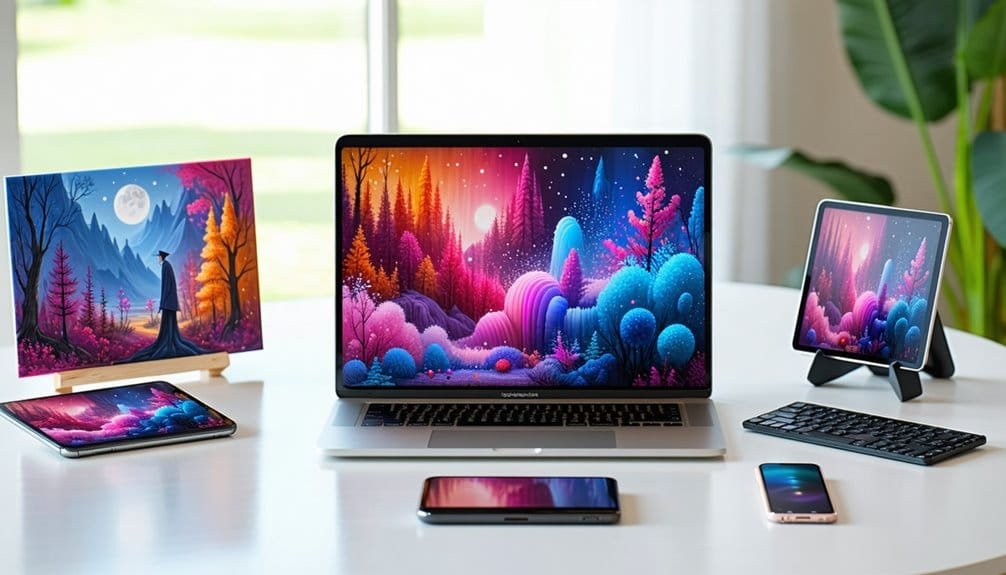
When you explore platforms for NFT art, ease of use and accessibility are key factors to take into account. Many platforms, like OpenSea and Crypto.com, offer user-friendly interfaces that simplify minting and trading processes, making it easy for you to get started. Additionally, multi-chain support across various platforms guarantees you can engage with NFTs on your preferred blockchain, enhancing your overall experience. Some marketplaces, such as LooksRare, even reward users for trading, further incentivizing participation.
User-Friendly Interfaces
User-friendly interfaces are essential for engaging with NFT art platforms, especially for newcomers. A well-designed platform enhances user experience by simplifying the process of creating, buying, and selling NFTs. You want an interface that’s intuitive and accessible, allowing you to focus on your art rather than getting lost in complicated navigation.
- Intuitive Design: Platforms like OpenSea offer easy navigation, ensuring you can quickly find what you need.
- Streamlined Tools: Fotor provides templates and editing options that make creating NFTs effortless.
- Multi-Device Support: With tools like SketchAR, you can access the platform from various devices, enhancing convenience.
- Beginner-Friendly Systems: Mintable allows you to start creating without needing advanced development skills.
- Visual Enhancements: Hotpot can produce NFT collections with tools designed to elevate your artwork’s quality. Additionally, user-friendly interfaces reduce time spent navigating menus and encourage experimentation without technical barriers. Furthermore, many platforms are designed to accommodate both non-developers and aspiring artists, making it easier for everyone to enter the NFT space.
Multi-Chain Support
Steering through the world of NFTs becomes even more streamlined with multi-chain support, allowing you to interact with various blockchains without hassle. This feature markedly enhances accessibility and usability, making it easier for you to manage your digital assets. Platforms like OpenSea and Rarible enable cross-chain transactions, which means you can buy, sell, or trade NFTs across different blockchains seamlessly. This blockchain interoperability not only saves you time but also opens up a broader marketplace for your NFTs.
For example, OpenSea supports multiple blockchains, including Ethereum and Polygon, while Rarible offers similar flexibility. Binance NFT stands out with its low fees, making it an attractive option for large-scale trading. Additionally, Mintable’s gasless minting on Immutable X reduces costs for creators, adding to its appeal. As the NFT market continues to grow, over $40 billion worth of assets traded across platforms reflects the increasing demand for diverse and accessible marketplaces.
While platforms like Foundation focus on curated, high-quality art, they could benefit from multi-chain support to reach a wider audience. Ultimately, multi-chain support empowers you to navigate the NFT landscape with greater ease and security, ensuring that your investments are both accessible and versatile.
Security and Trustworthiness
In the world of platforms for NFT art, security and trustworthiness are paramount for both creators and collectors. You want to guarantee your digital assets are protected and that the platforms you choose implement robust security protocols. Top platforms utilize various strategies to maintain a secure environment, incorporating key trust factors that enhance user confidence.
Consider these crucial security measures:
- Encryption and Decryption: They convert your NFT data into unreadable formats during storage and transmission, safeguarding it against unauthorized access.
- Watermarking and Metadata: Unique identifiers embedded in files discourage unauthorized duplication and help establish ownership.
- Smart Contract Audits: Thorough audits detect vulnerabilities in smart contracts, guaranteeing they’re secure before deployment.
- In-House DRM: Custom digital rights management solutions provide robust encryption and access control.
- Image Recognition Software: AI tools analyze visual patterns to prevent unauthorized distribution of your art.
Despite these measures, be aware of potential vulnerabilities. Centralized marketplaces can expose your private keys, and weak passwords can lead to account hacks. Phishing attacks are also a real threat; always remain vigilant against malicious links.
Ultimately, choosing a platform with strong security protocols and trust factors is essential. By understanding the various protection strategies and potential risks, you can make informed decisions to secure your digital assets effectively. The right platform will give you peace of mind, allowing you to focus on what truly matters: your art.
Choosing the Right Platform
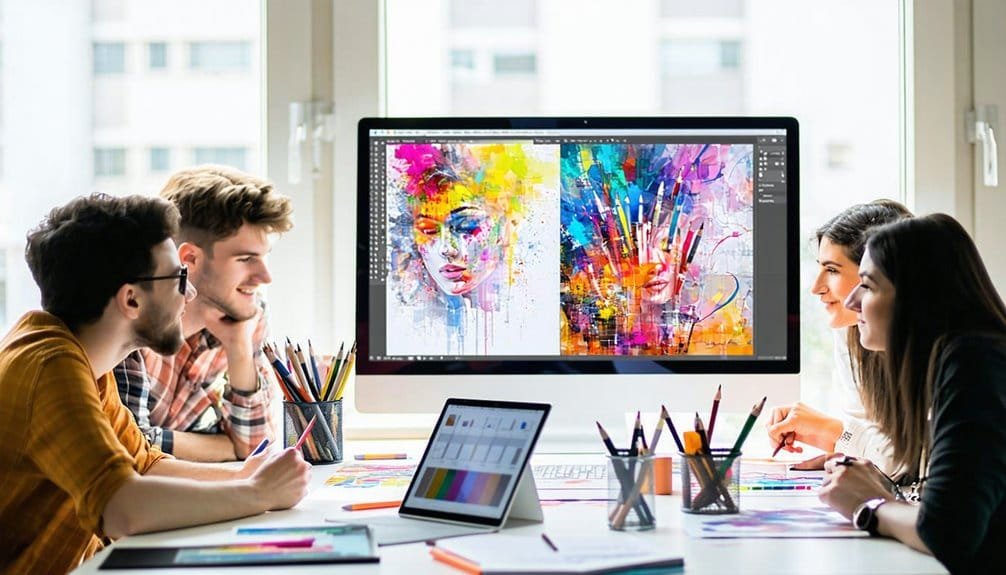
When selecting an platforms for NFT art, it’s important to take into account various factors that align with your goals as a creator or collector. First, consider the market focus and specialization of each platform. For instance, if you seek high-quality digital art, platforms like Foundation or SuperRare may be ideal. In contrast, OpenSea offers a broader range of digital assets, allowing for more platform comparisons and flexibility.
Next, evaluate the fees and royalties associated with each platform. OpenSea has a relatively low fee of 2.5% on secondary sales, while Foundation charges 5%, plus royalties. Understanding these costs can greatly impact your profits, making it necessary to assess how they align with your financial goals.
User base and accessibility also play a significant role in your decision. OpenSea boasts over 2.5 million users, providing a vast audience for your creations. If exclusivity is important, platforms like Foundation operate on an invitation-only basis, which may limit exposure but offer a curated experience.
Frequently Asked Questions
How Do I Create My First NFT on These Platforms?
To create your first NFT, start with the initial setup requirements, like creating an account and connecting a secure digital wallet. Next, follow the NFT creation process, which typically involves uploading your digital assets, adding attributes like title and description, and setting your desired price. Each platform has its unique features, but they all prioritize user-friendly interfaces, ensuring you can mint and list your NFT safely and efficiently.
Can I Sell Physical Artwork as an NFT?
Yes, you can sell physical artwork as an NFT on various NFT marketplaces. By tokenizing your physical art, you create a digital representation that serves as proof of ownership. This process often includes secure storage and a certificate of authenticity linked to the NFT. However, consider challenges like provenance tracking and legal regulations. Using established platforms can enhance safety, ensuring transparent transactions and protecting your rights as an artist or collector.
What Are the Tax Implications of Selling NFTS?
When you sell NFTs, you’re subject to capital gains tax, which varies based on how long you hold the asset. Short-term gains are taxed as ordinary income, while long-term gains enjoy a lower rate. You must adhere to reporting requirements, making certain all transactions are documented accurately. Tax deductions may apply to losses, which can offset gains. It’s vital to understand these legal obligations to avoid penalties and guarantee compliance with tax regulations.
How Do I Promote My NFTS After Listing Them?
To promote your NFTs after listing, leverage social media platforms like Twitter and Instagram to showcase your work. Engage actively with potential buyers and participate in NFT communities. Consider forming influencer partnerships, as these can greatly increase your visibility. Share behind-the-scenes content to generate interest, and attend NFT events to build networks. Analyzing your strategies and adjusting based on audience feedback guarantees your marketing efforts remain effective and relevant.
What Types of Digital Art Are Most Popular on These Platforms?
On NFT platforms, digital illustrations and animated artworks are among the most popular types of digital art. Digital illustrations often showcase intricate designs and storytelling elements, appealing to a broad audience. Meanwhile, animated artworks add a dynamic touch, incorporating movement and sound, which can enhance viewer engagement. Both formats attract collectors and artists alike, making them highly sought after in the evolving digital art landscape. Understanding these trends can guide your own creative endeavors.
Summarizing
To sum up, selecting the right NFT art platform involves considering various factors like features, fees, user engagement, and security. Each platform caters to different needs and preferences, so it’s crucial to evaluate what matters most to you. By understanding these aspects, you can make a more informed decision that aligns with your artistic goals and guarantees a reliable experience. Ultimately, the right choice can enhance your journey in the evolving world of NFT art.


